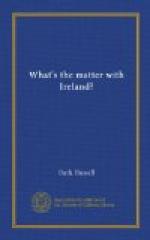“Ireland offers opposition in the person of the ‘gombeen man.’ He is the local trader and money lender. And co-operative buying and selling takes away his monopoly of business.
“Paddy Gallagher up in Dungloe in the Rosses will give you an idea of the poverty of the Irish countryside, of the extent that the poverty is due to the gombeen men, ‘the bosses of the Rosses,’ and of the ability of the co-operative society to develop and create industry even in such a locality.
“Societies like Paddy Gallagher’s are springing up all over Ireland. The rapid growth may be estimated from the fact that in 1902 their trade turnover was $7,500,000, and in 1918, $50,000,000. These little units do not merely develop industry; they also bind up the economic and social interests of the people.
“In a few years these new societies and others to be created will have dominated their districts, and political power will follow, and we will have new political ideals based on a democratic control of agriculture and industry, and states and people will move harmoniously to a given end.
“Ireland might attain, by orderly evolution, to a co-operative commonwealth in fifty to two hundred years.
“But these are dangerous times for prophecy.”
PADDY GALLAGHER: GIANT KILLER.
From the dark niche under the gray boulder where the violets grow, a Donegal fairy flew to the mountain cabin to bring a birthday wish to Patrick Gallagher. The fairy designed not that great good would come to Paddy, but that great good would come to his people through him. At least when Paddy grew up, he slew the child-eating giant, Poverty, who lived in Donegal.
Paddy began to fight poverty when he could scarcely toddle. With his father, whose back was laden with a great rush basket, he used to pad in his bare feet down the mountainside to the Dungloe harbor—down where the hills give the ocean a black embrace. Father and son would wade into the ocean that was pink and lavender in the sunset. Above them, the white curlews swooped and curved and opened their pine wood beaks to squawk a prayer for dead fish. But the workers did not stop to watch. Their food also was in question. They must pluck the black seaweed to fertilize their field.
When the early sun bronzed the bog, and streaked the dark pool below with gold, Paddy and his father began to feed the dried wavy strands of kelp between the hungry brown furrow lips. They packed the long groove near the stone fence; they rounded past the big boulder that could not be budged; last of all, they filled the short far row in the strangely shaped little field. At noon, Paddy’s mother appeared at the half door of the cabin and called in the general direction of the field—it was difficult to see them, for their frieze suits had been dyed in bog water and she could not at once distinguish them from the brown earth. They were glad to come in to eat their sugarless and creamless oatmeal.




